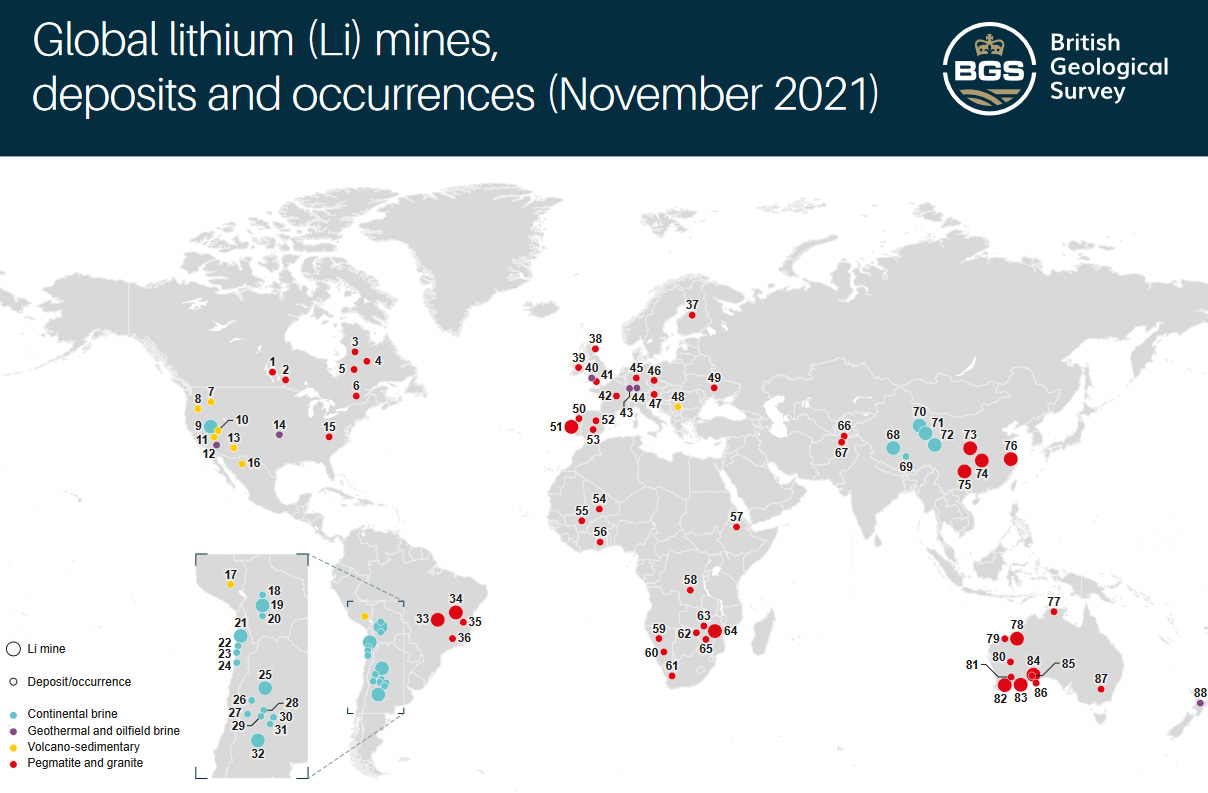Are We Running Out of Lithium?
Not exactly, but ...
Thank you for reading Lithium Horizons. Here we explore energy, innovation, and ideas from the frontiers of materials. You can subscribe for free to receive new posts directly in your inbox.
You may have heard that there is not enough lithium on Earth to meet the global demand for electric vehicles. Articles like these paint a gloomy picture of a world heading into a catastrophe. When you have the CEO of Stellantis, one of the largest European automotive manufacturers, proclaim that Earth doesn't have enough raw materials to meet the electric vehicle demand, then we really are in trouble.1 But wait a minute! If that’s the case, why is his company pushing for electrification? Won’t they need lithium for their batteries? And if they know that we don’t have enough lithium, then this must be some kind of a sick joke.
Before jumping to any conclusions, let’s get back to the basics. What is lithium?
Lithium (from Greek lithos = stone) is a soft metal with a silvery appearance that originates from space.2 It is the lightest solid material that finds its use in many industrial applications, such as metallurgy, glass production, optics, and rocketry. It is also used to treat psychological disorders like mania and bipolar episodes. However, it is mostly used for lithium-ion batteries.
Lithium is extremely reactive, undergoing a violent reaction with water. Due to this reactivity, it is never found pure in nature but always combined with other elements to form various compounds. That is why, extracting lithium has been somewhat of a challenge. Common sources of lithium are:
Pegmatite deposits
Sedimentary clays
Brines
Pegmatite deposits are of volcanic origin. Within pegmatites, lithium is often found in a mineral called spodumene. This is the origin of lithium coming from Australia, and it occupies an increasing share of the market. Sedimentary clays are a newly explored option and are being presented as an alternative source of lithium. The Jadar mine, for example, is rich in these deposits. Finally, brines, mostly from South America and China, are the traditional sources of lithium.

Yet, these are not all our options. Another source of lithium is the ocean, and possibly seabed, as discussed in my previous article.3 While, this approach is not economical for now, it presents an option that is being heavily researched. Moreover, new deposits are being found all the time. For example, did you know that deserts are potentially rich in lithium?
Because of all of that, we don’t really know how much lithium we have on Earth, but one thing is sure: we aren’t running out of lithium. As Hannah Ritchie writes: ‘‘You might imagine that a chart of known reserves or resources over time would go down. But it’s the opposite: I’ve charted them below, and you can see them going upward because we're discovering new deposits much faster than we're using them up.‘‘
There is no problem of availability, but that of accessibility. How do we get to all of that lithium in a sustainable way? Most lithium mines are not active yet, and it takes a couple of years to get a mine up and running. Yet, lithium mining, like most mining activities, is harmful to the local ecosystem.
A possible alternative is direct lithium extraction (DLE) from solutions, such as brines. It is still at an early stage, but it has the potential to be more efficient, cheaper, and less harmful to the environment. Also, it would be a step in the direction of tapping the vast lithium resources in the seas.

Whatever we do, we should let innovation take its path. While lithium has its own challenges, availability is not one of them.
That’s all for now. Until next time 🔋!
Thank you for reading this article, I hope you enjoyed it! Feel free to share it with your friends.
Carlos Tavares, the CEO of Stellantis, said: ‘‘We know that we need lithium. We know that we are not producing as much as we need. We have right now 1.3 billion cars (that are) internal combustion engine powered on the planet. We need to replace that with clean mobility. That will need a lot of lithium. Not only the lithium may not be enough, but the concentration of the mining of lithium may create other geopolitical issues.‘‘ Now, I see this as a testament to the challenges we are facing with regards to lithium, not as a definitive conclusion as the bombastic headlines of newspaper may lead you to believe. After all, he said that lithium may not be enough and not that lithium is not enough.
Classical novae are cosmic explosions that happen in binary systems consisting of a white dwarf and an orbiting star. When hydrogen and helium from a star falls onto the white dwarf surface in sufficient quantities, it triggers a runaway thermonuclear fusion reaction that produces heavier elements.
It is estimated that seas contain 230 billion tonnes of lithium.

